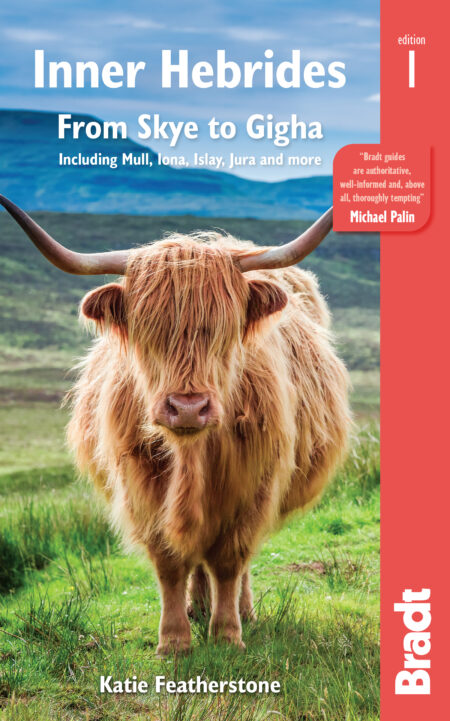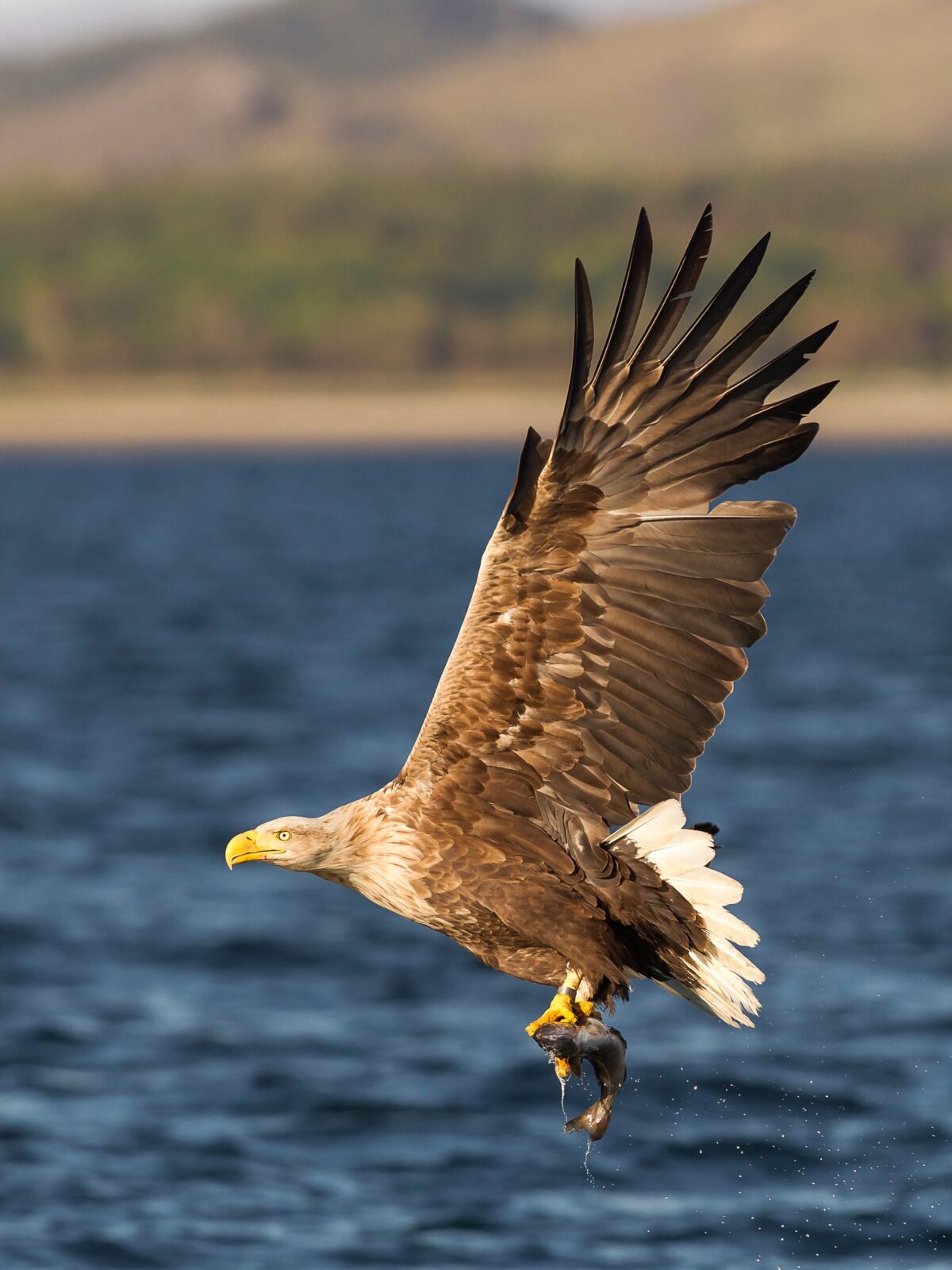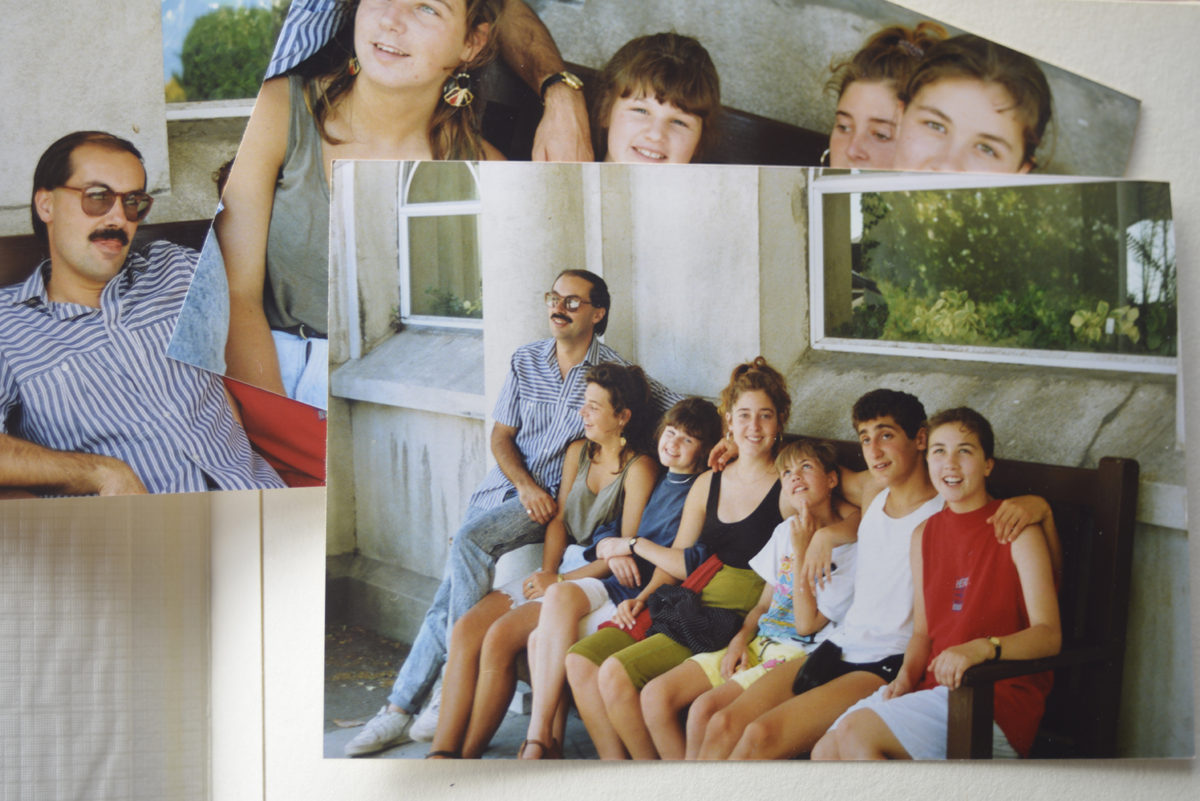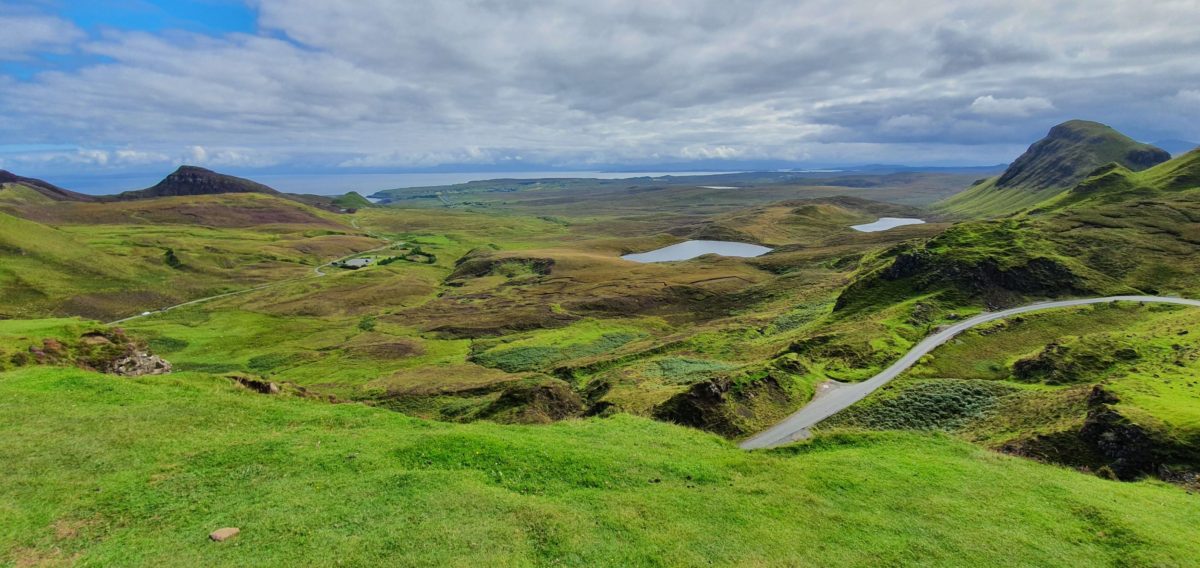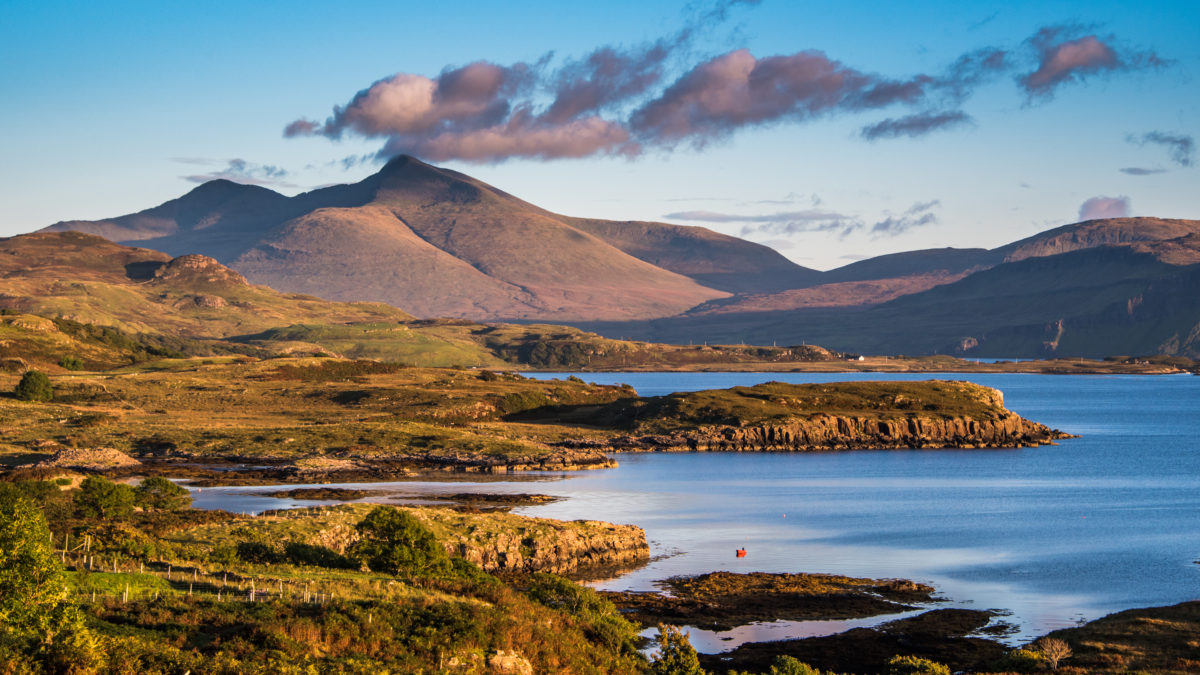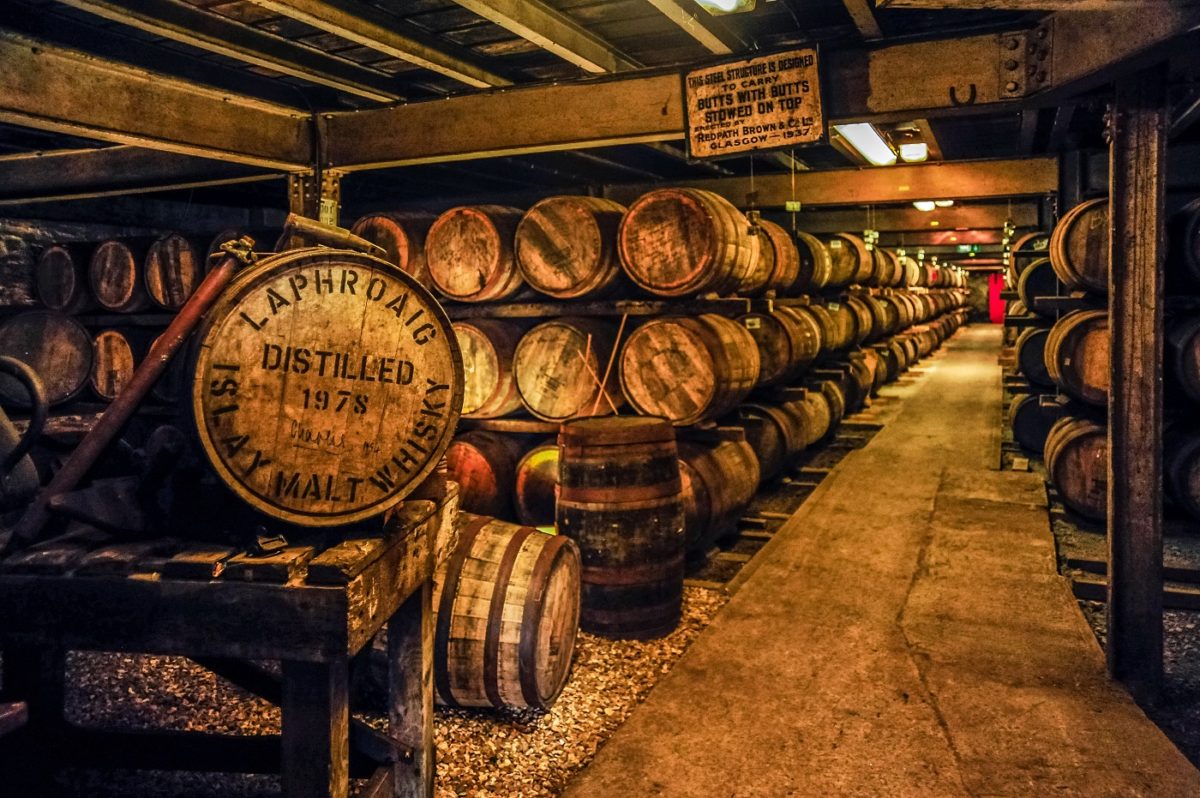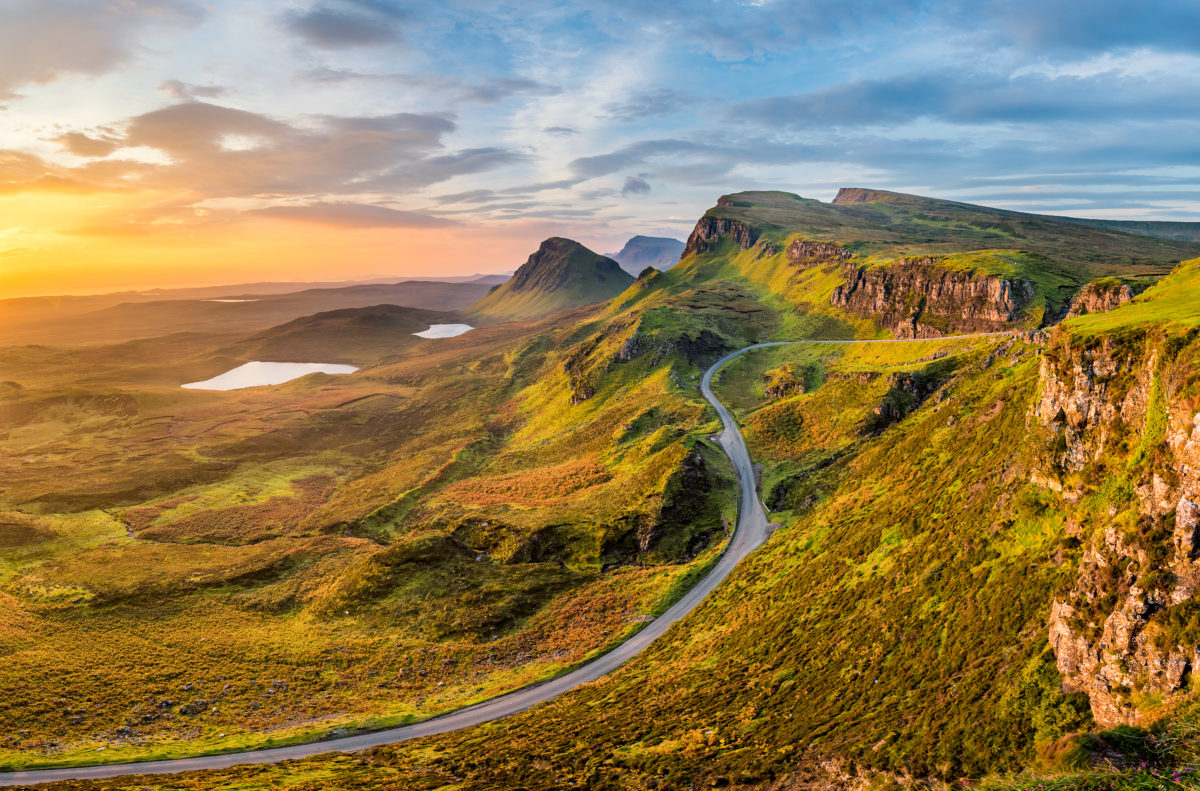Whichever islands you choose to visit, you can be sure to feel a world apart from mainland Great Britain.
Katie Featherstone, author of Inner Hebrides
Splintering off Scotland’s west coast, the Inner Hebrides is a loosely scattered archipelago that includes all the islands from Skye in the north to Islay and Gigha in the south; they stretch as far west as Tiree and cut into the mainland to the east, with Lismore and Kerrera sitting in the Firth of Lorn.
Surrounded by miles of intricate coastline, with vast swathes of wilderness inland, the Inner Hebrides is a haven for wildlife and a particularly important habitat for coastal birds and marine mammals. Sightings of seals are almost guaranteed, while even luckier or more patient visitors have a chance to spot otters, basking sharks and even minke whales.
With Scotland’s ‘right to roam’, well-prepared hikers have infinite possibilities on the islands. Large areas of each map remain uninhabited and there is a high likelihood of being able to enjoy Mull’s dramatic rock formations or Jura’s Paps without the interruption of another person in sight.
The islands’ modern-day charms and gentle demeanour give little indication of their turbulent past: Irish monks and Viking invasions, the creation of the Lords of the Isles’ kingdom and subsequent clan warfare. These long-lost civilisations left behind ruined castles, intricate carvings and crumbling chapels, sprinkling the islands with fascinating archaeology.
Food and drink in Inner Hebrides
Local food
Although there is more to Scottish cuisine than haggis, first-time visitors to Scotland should try to forget their preconceived notions and be prepared to try it. Traditionally held together in an animal’s stomach, the tasty filling contains sheep’s heart, liver and lungs, minced onion, oatmeal, suet, pepper and salt along with other spices. Unlike other depressing meat substitutes, vegetarian haggis is remarkably tasty; it usually includes beans, pulses and nuts in addition to the usual non-meat ingredients.
Look out too for Cranachan, a delicious dessert made from oats, cream, whisky and raspberries. For breakfast, porridge is a must; medium-ground oats are preferred and serving suggestions range from just a pinch of salt to sugar and a tot of whisky. Look out too for the square Lorne sausage, usually made from beef, which can be tried on the CalMac ferry, if not before.
Local seafood and venison are some of the islands’ most luxurious abundances. You can also find free-range eggs, homemade jams or chutneys and other fresh produce sold from people’s gateways and other unexpected places. Mull is particularly rich in honesty box shops, despite being one of the bigger and more frequently visited islands, and the excellent Mull and Iona Food Trail helps visitors locate these hidden gems.
Drinks
Many people travel to Scotland especially because of their love of whisky, and if you appreciate a peaty dram then there is no more rewarding destination than Islay, which currently has nine working distilleries and rumours of others reopening or starting up soon. Many of the distilleries run tours, which allow you to see the inner workings of the process and try a few ‘samples’ along the way.
Jura, Skye, Raasay and Mull also all have their own whisky distilleries, so a grand tour of the Inner Hebrides or several shorter trips, with the aim of visiting them all, would be an interesting plan for enthusiasts.
Newer on the scene are artisan gins, craft ales and even rum; it is claimed that Colonsay is the smallest island in the world with its own brewery. You can try all of these, as well as whiskies, in local pubs and restaurants. In the 1970s, an Englishman visiting an island pub would have had difficulty ordering his normal pint of bitter and may have had to refer to it as ‘a pint o’ heavy’, or maybe a ‘half and a half pint’ to be understood. These days drinks at the bar are international, but it is always worth asking the bartender if they serve anything local and they might even give you a little backstory about where it is made.
Eating out
Thirty years ago you would have been lucky to find a fish and chip shop on most Scottish islands, but the Inner Hebrides are now starting to gain international recognition for their quality ingredients and small collection of exceptional restaurants.
Loch Bay, on Skye’s Waternish Peninsula, currently holds the Inner Hebrides’ only Michelin star, but a further eight restaurants are listed in the Michelin guide. Five of these are on Skye, mostly clustered in the northwest: The Three Chimneys; the Edinbane Inn; Scorrybreac; and Coruisk House. Three are on Mull: Pennygate Lodge, Highland Cottage and Ninth Wave.
Of course, the Michelin Guide is not the be-all and end-all of fine dining, and many of the smaller islands also have excellent places to eat. There are also many relaxed mid-range restaurants and cosy pubs serving good food along the lines of hearty venison pies, local seafood and Aberdeen Angus steaks.
Health and safety in Inner Hebrides
Health
Access to non-emergency medical services on the islands is limited and many places do not even have a pharmacy. For peace of mind, you should stock up on any medication you regularly need before your trip.
The majority of islands do have some form of doctors’ surgery, district nurse or community nurse. Hospitals are only located on Skye, in Portree and Broadford and in Bowmore on Islay; on the mainland you can also find them in Lochgilphead, Oban and Fort William, but serious or specialist cases are often flown to Glasgow.
Although this apparent lack of services might seem intimidating, it is important to realise that although health care might not come in a form that you are accustomed to, there is always a plan of action in place: well-trained community first responders are on call nearby, dispensing doctors can prescribe medicine where pharmacies are not available and health professionals generally have more time to spend on each patient than you would find in busier parts of the UK; brand-new defibrillators are also now attached to walls in many places across the islands.
Note, too, that prescriptions are free in Scotland. Dentists are few and far between, often only offering emergency appointments.
Safety
In terms of both residents and visitors, the Inner Hebrides are very safe. Most inhabitants do not bother to lock their doors and if any criminal activity was to take place then the culprits could not get very far before being stopped at the ferry terminal; in many places, the honesty box shop is still a workable business model.
Outdoor emergencies
To reach Mountain Rescue, just call the normal emergency number (999 or 112) and ask for ‘police, mountain rescue’. Do the same to call the coastguard and simply ask for ‘coastguard’. You can also contact 999 via SMS text message, which might be easier in areas of poor network coverage, but it is easier for the emergency services if you have registered your phone in advance; this service should only be used when a phone call is not possible.
The best way to avoid getting into trouble in the first place is to be well prepared and understand your own capabilities. Land- and seascapes that appear gentle in photos can turn out to be much more severe with the addition of Scotland’s famously relentless weather. If you are unsure of your ability or a total beginner, don’t try something new without being accompanied by a more experienced and trustworthy friend or guide.
Though walking is the most accessible activity on the islands – and one which many people can enjoy with appropriate clothing and a little forward planning – navigation becomes vital when hillwalking inland. Map-reading skills and a compass, along with the possible addition of a GPS device, are essential.
When swimming in the sea, it is important to be aware of rip tides. If you find yourself being dragged out, do not fight the current, but swim out sideways, parallel with the shore, to escape. Another obvious hazard can be waves. You should be able to tell if the sea looks too rough to swim in, but even on calmer days you can hurt yourself by being pushed on to the rocks at the side of a bay. Only very confident swimmers who are used to similar conditions should swim out of their depth when alone at the beach.
Travel and visas in Inner Hebrides
Visas
The Inner Hebrides are part of the UK, so visitors from the EU do not currently need a visa. However, now that the UK has left the European Union, documentation requirements for EU citizens may change – especially once the transition period has ended in January 2021; check before travelling.
People coming from the United States, Canada, Australia and other countries should follow the same procedures as entering the UK elsewhere.
Getting there and away
The Inner Hebrides range from relatively remote to quite accessible depending on your choice of destination. While it might take 4 hours to reach Tiree from the mainland, or you could have to wait a couple of days to catch a ferry to Canna, driving across to Seil or Skye takes a matter of minutes. In all cases, the journey should be considered a part of your trip, as mainland Argyll and the Highlands are beautiful parts of Scotland and ferry journeys provide great wildlife-watching opportunities in the open sea.
Note that it’s not necessary to have a car to visit the Inner Hebrides, but – with the exception of Skye and Seil where some buses run directly over the bridge – in order to reach the islands by public transport you will generally have to change and get on to the ferry on foot.
Ferry travel
The vast majority of ferry services are run by CalMac. Of the main port towns, Mallaig serves the Small Isles and Skye; Oban serves Mull, Coll, Tiree, Colonsay and Lismore; Gallanach, just south of Oban, has ferries to Kerrera; to reach the Slate Islands, you will first have to travel to Seil; Kennacraig, which is really little more than a shed ferry terminal in a large car park, serves Islay; and ferries to Gigha leave from Tayinloan.
You can also travel to Raasay from Sconser on Skye; to Colonsay from Port Askaig on Islay; to Iona from Fionnphort; and to Ulva from Ulva Ferry on Mull.
By bus and rail
Trains to Oban, Mallaig, Arrochar and Tarbet (the last two for bus connections towards Kennacraig and Tayinloan) leave from Glasgow Queen Street. Times and fares can be checked via ScotRail.
The journey from Glasgow to Oban by both bus and train takes just over 3 hours, with departures every couple of hours throughout the day. Travelling to Mallaig takes just over 5 hours with only a couple of departures each day and the possibility of needing to change in Fort William.
It takes just over 3 hours to reach Kennacraig, for connections to Islay, by Citylink bus, whereas travelling to Tayinloan (for Gigha) adds a further 30 minutes and a couple of pounds more; there are departures a few times a day.
Travel between the islands
By road
Almost all roads in the Inner Hebrides are paved and, excluding a few good stretches on Skye and a couple on Mull and Islay, the vast majority are single track. The condition of the roads is a point of much contention among locals who are accustomed to driving on narrow roads, but resent the inconvenience and damage caused by pot-holes.
You can generally expect the quality of roads to decrease in accordance with the size of the population and proximity to the mainland: although single track, Seil’s roads are smooth and painless, whereas those on Skye’s northern Waternish Peninsula, the west coast of Mull and towards the north of Raasay are more dubious.
Jura deserves a special mention for its only substantial road: the A846. The classification as an A road should not confuse visitors into assuming it will be well maintained – the northern section sees grass growing in the middle and in places the sides are so sunken that a small car is likely to occasionally graze the road with its undercarriage.
By ferry
Routes between islands are more limited and less frequent than those between the islands and the mainland, making it impossible to explore the whole archipelago without intermittently visiting the mainland; fortunately, Argyll and the Highlands are both beautiful parts of Scotland, so this is really no hardship.
That said, it is possible to travel between some of the islands: Coll and Tiree; Islay to Jura and Colonsay; between some of the Small Isles; Seil to Easdale and Luing; Skye to Raasay; and Mull to Iona and Ulva.
By bus
With a little forward planning, a holiday or trip around some of the Inner Hebridean islands by bus is perfectly possible and allows you the extra luxuries of being a little higher above the ground and not needing to watch the road, so you can relax and enjoy the scenery.
Bus services on the islands, though reliable, comfortable and convenient where they exist, have limited routes and timetables. Generally, schedules work around school times rather than the arrival of ferries, so there might be some wait between connections. On Sundays, services are dramatically reduced and often do not run at all.
When to visit Inner Hebrides
As with any destination, but possibly more than most, your impression of the Inner Hebrides will be greatly affected by the weather. Beautiful and unspoilt in sunshine, it suddenly becomes all too apparent when it rains that the smaller islands are severely lacking a coffee shop. To add to the adventure, seasonal conditions are totally impossible to predict in advance, with clear bright days in winter being just as common as whole weeks of rain in July.
Then there’s also daylight hours: the summer solstice on 20 June sees 18 hours of daylight on Skye while the shortest day of the year (21 December) lasts for just 6 hours and 37 minutes. However, with the right mindset, clothing and interests any time of year can be enjoyable, but there are a few general trends to bear in mind.
Spring (March to May)
As hours of daylight increase around March and the year opens out into spring, the islands begin to emerge from their winter slumber. Although few visitors take advantage of these months, they are arguably the most rewarding.
Temperatures are still relatively low in March, but April, generally known in the UK for its showers, is actually often a sunny time on the islands. Even if it rains, you will see a wonderful show of wildflowers as well as many species of birds returning from their winter migration. The midges don’t tend to come out in force until around 20 May, making spring a good time to avoid them.
One downside of coming early is that seasonal attractions, cafés and places to stay do not generally open until the middle of April and sometimes stay closed until June; that said, it is a perfect time to visit the most popular natural attractions, such as Skye’s Old Man of Storr, as the majority of visitors will not arrive until the summer. Seabirds start nesting on the cliffs in March, but the few places with breeding puffins are best visited from the beginning of May until August.
Summer (June to September)
Most people visit the Inner Hebrides in summer and there are several enticing reasons for visiting at this time of year. Nights are at their shortest in late June and the following couple of months are the best time to see basking sharks and marine mammals such as porpoise, dolphins and minke whale.
Summer is also the main time to attend festivities including fèis events of traditional Gaelic arts and culture, Highland Games, agricultural shows and other local traditions. Accommodation generally needs to be booked in advance and the most popular attractions are likely to be busy but, if you get off the beaten track or just walk a little further you’ll likely find that the majority of places are still free to explore in solitude.
Autumn (October to November)
The summer stretches into September before starting to fade away into autumn, with a higher likelihood of storms and temperatures beginning to drop. With geese returning in their thousands, stags rutting and broad-leaved trees in their golden and copper finery, autumn is a great time for nature lovers.
Many places close in October, their owners catching up with creative projects or maintenance work; this can make it increasingly difficult to find places to eat out or visit (aside from those that are outside or open access). Accommodation options are more limited, but those that do stay open often cut their rates significantly.
Winter (November to February)
Serious hiking and many other outdoor activities start to become infeasible in November and December, with short hours of daylight, snow on high mountaintops and unpredictable weather. Although the long winter nights are perfect for being cosy by the fireplace, in clear weather the cold nights are also great for stargazing; with so little light pollution, the sky puts on an incredible display and it’s sometimes even possible to see the northern lights. Christmas and Hogmanay (New Year’s Eve) are festive celebrations with hearty food and drink, best spent at home with family or at the local pub.
If not before, almost everywhere closes in January and February, and the now seemingly endless winter drags on with storms, freezing temperatures and occasional, glorious respite. Few people choose to visit at this time of year, but those that do often have the feeling of having an island to themselves.
What to see and do in Inner Hebrides
With the greatest joy coming from accidental otter spotting, strolling across empty expanses of sand and finding hidden archaeology among overgrown heather, the Inner Hebrides is really a region to discover your own highlights. That said, there are of course some things that should not disappoint.
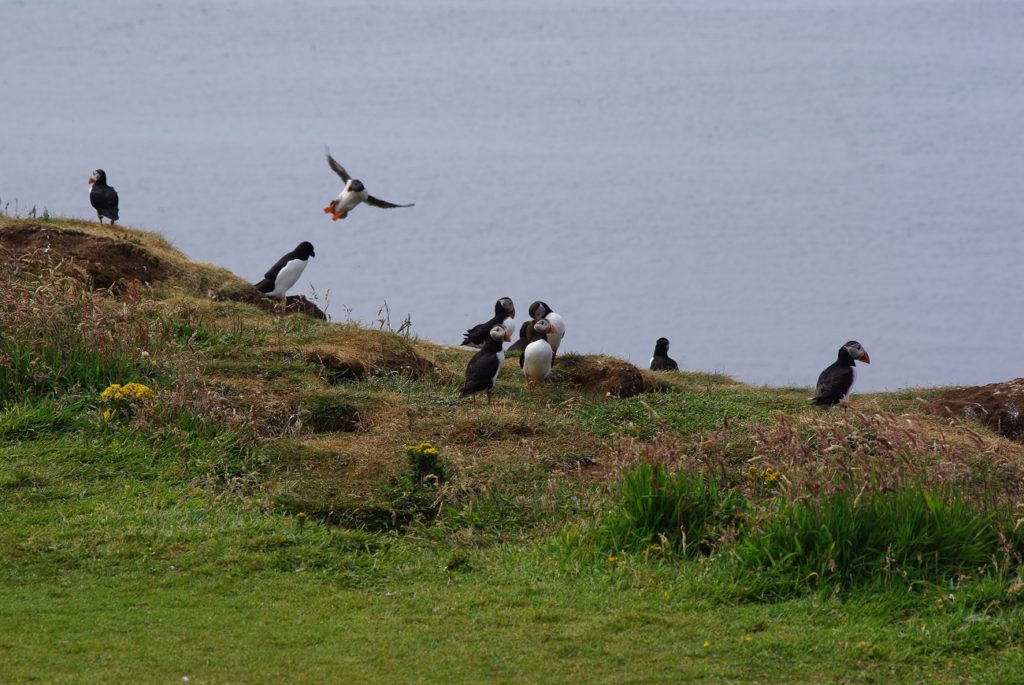
Wildlife
All the islands have great wildlife-watching opportunities, but excursions to see puffins on the Treshnish Isles or Sanday in the Small Isles at the right time of year are undoubtedly one of the most guaranteed and rewarding experiences.
Witnessing 37,000 geese returning to Islay around early to mid-October , visiting the teeming seabird cliffs on Colonsay or the Manx shearwaters on Rùm are welcome reassurance about the natural world.
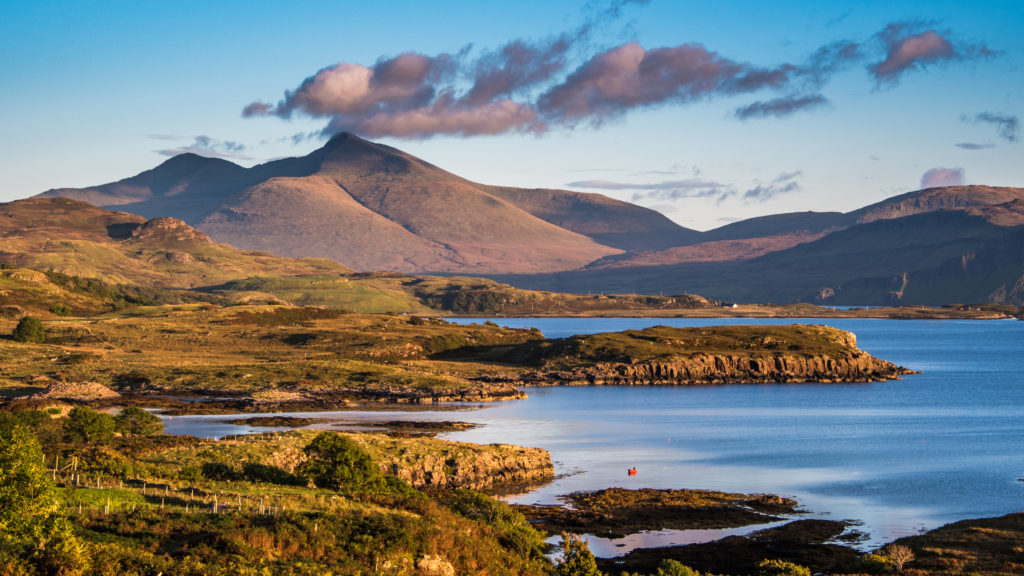
Walking and climbing
Mountaineers will find their best options in Skye’s Cuillins, but hikers and hillwalkers will love Ben More on Mull, Jura’s Papsand the huge nature reserve of Rùm.
On Coll and Tiree particularly, visitors are spoilt for choice over deserted sandy beaches, but Islay, Mull, Gigha and Colonsay all have more than their fair share.
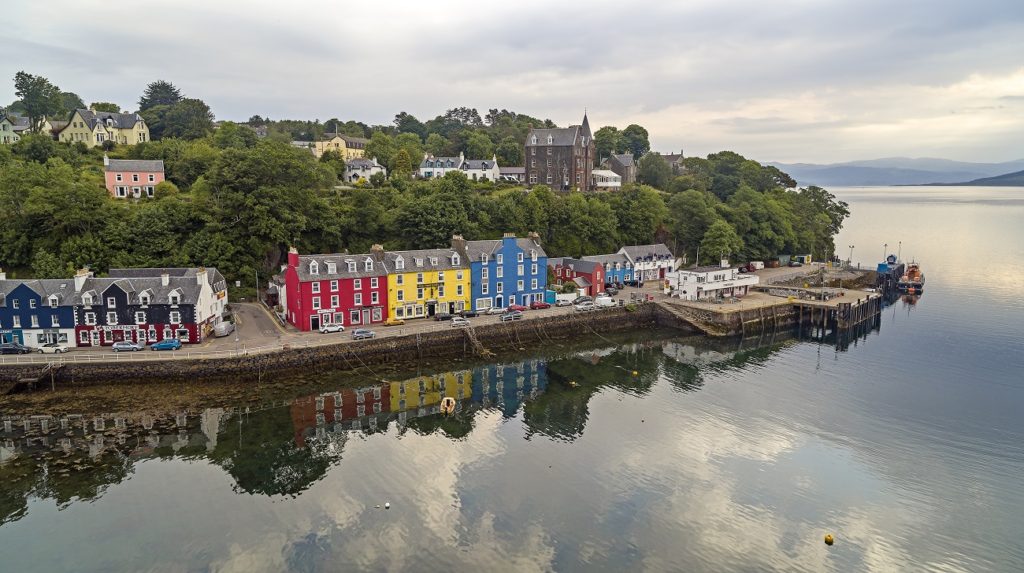
Food, history and culture
Islay is known primarily for its whisky and visiting some of its distilleries will undoubtedly be a highlight for enthusiasts. Portree has the best variety of places to eat and drink, while colourful Tobermory is a fun place to spend an afternoon whatever the weather.
The restored splendour of the imposing fortress of Duart Castle and Iona Abbey, with its connection to Columba and huge collection of carved medieval grave slabs, are some of the most interesting and impressive historical sites across the islands. Equally important, but slightly less well known, are the priory on Oronsay and Islay’s Finlaggan.
Suggested itineraries
These islands should not be rushed and, while they are all different, you will get more enjoyment from a two-week trip to just one or two islands than you possibly could from trying to visit seven within the same period. That said, the smaller and more accessible islands – the Slate Islands, Lismore, Kerrera and Gigha – can be visited on short trips of a couple of days.
One week could easily be spent on any of the islands, but you could also visit a couple in the same area: some of the Small Isles; the Slate Islands and Lismore; Islay and Jura or Colonsay; or Coll and Tiree.
Two weeks will give you enough time to relax and explore some of the large islands like Skye, Mull or Islay at a more leisurely pace. Within two weeks, you could also comfortably visit all of the Small Isles or hopscotch from Oban to Colonsay to Islay and then over to Jura.
Those who have longer than two weeks and want to explore more of the region should first look at the ferry connections to see which islands are linked together. Unlike the Outer Hebrides, which are essentially strung out in a long strand, travelling between the Inner Hebrides is a stop-start affair that involves multiple trips to the mainland.
Visiting every island at a relaxed pace takes around three months and should ideally be planned to coincide with the seasons: Skye is much further north than Gigha, for example, and gets cold earlier in autumn and warms up later in spring.
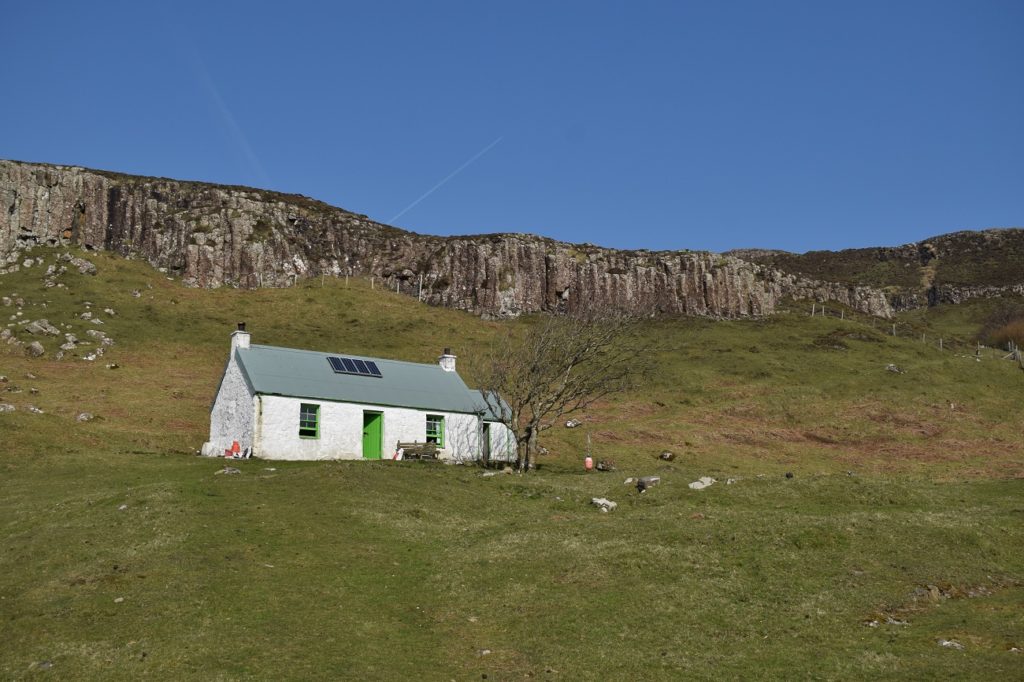
Canna
Arguably the most remote of all the Inner Hebrides, Canna and Sanday feel like a reward for those who take the time to travel there. Joined by a bridge, the two islands share a community and are most often referred to as a single entity, Canna.
Unspoilt and impossibly beautiful, Canna is structured like a tiered wedding cake with bands of basalt columns separating plateaus where the sheep and cows graze. These lush, green fields run down to the coastline, where there are towering sea stacks and secluded coves.
At low tide it is possible to walk across the sand between the two islands, but there has been some form of connecting bridge since the late 19th century. Canna is the larger of the two islands and currently houses more of the population, although this has not always been the case.
Peace, wildlife and scenery are many people’s reasons for coming to the Hebrides and it’s hard to find anywhere better than Canna for these things. The lime-based basalt columns form many of Canna’s towering cliffs and rocky protrusions. Healthy white cheviot and unusually tall, brown zwartble sheep graze on remarkably green grass along with two types of cow: Aberdeen Angus and the visitors’ favourite Highland cattle. Excluding rabbits, of which there are plenty, wild land mammal species are limited. There are, however, otters and several colonies of grey seals.
Between June and September, enormous basking sharks can sometimes be seen from the shore and the very luckiest of people might spot porpoise, dolphin and even occasionally killer whale. More (seasonally) reliable are the seabirds, particularly puffins, kittiwakes, shags, guillemots and razorbills, all of which nest on the islands. There is also a nesting pair of golden eagles and a pair of sea eagles, as well as peregrine, long-eared owls and numerous other species.
What to see and do
Canna Harbour
With sailing boats bobbing on the water and views across to Sanday, and backed by two churches (and a third across the water), Canna Harbour must be one of the most picturesque in Scotland, and a wander around it is an inevitable part of any visit.
The harbour’s first landmark is the rounded, brown-stone Rhu Church, built in the early 20th century as a memorial to the previous owner of the island, Robert Thom, and aptly known as the Rocket for its cylindrical, pointed spire.
Following the road north and then west around the harbour, you’ll first pass the shop and Canna Café, before seeing a gate leading to Canna House. Canna’s obvious ‘Big House’ was built around 1863 by Donald Macneill and was later home to Canna’s last private owners, the historian and folklore scholar John Lorne Campbell and his wife Margaret. The house is currently closed to the public, but visitors are welcome to explore the gardens (free).
A further 550yds past here is the small, white Change House, built in the late 18th century and still inhabited today; here you’ll also find the island’s phone box and post office. Another 220yds west will take you to the old mill stone and St Columba’s Chapel; the latter had a short interlude as the post office before being returned to a religious building.
Sanday
At just 0.71 square miles, Sanday is only a sixth of the size of Canna, with much of the western end of the island designated as crofting land. Even if you only have time for a flying visit, the beautiful sandy beach, Traigh Bhàn, makes a trip across the bridge worthwhile. The beach is hidden behind the sand dunes and rocks just a couple of hundred metres to the west of the bridge. In spring, the hill behind the beach is colourful with wildflowers.
The east side of Sanday is accessed by the coastal road, to your left after you cross the bridge, which runs as far as St Edward’s Church. This Roman Catholic church was built in 1890, after the Clearances on Canna, when there was a much larger Catholic community on Sanday. It was also used by visiting fishermen from Barra and Eriskay, but has always had problems with damp and has now fallen into disrepair.
Heading southeast along the stone wall from the church will take you to the southern coast. This is the quiet end of the island and a wonderful place to see seals among the skerries and wading birds, such as lapwings with their slow irregular flight and wailing call. Rùm dominates the views from here.
From here, follow the coast anticlockwise until you reach the spectacular grassy, flat-topped sea stacks of Dùn Mor and Dùn Beag. From the end of April to July there are puffins nesting here, but other seabirds such as guillemots, fulmars, kittiwakes, razorbills and shags can also be seen.
Following the coastline north and then west, you’ll pass the small lighthouse and then a couple of secluded coves. Don’t forget to look out to sea, as there are good chances of seeing basking sharks during the summer months.
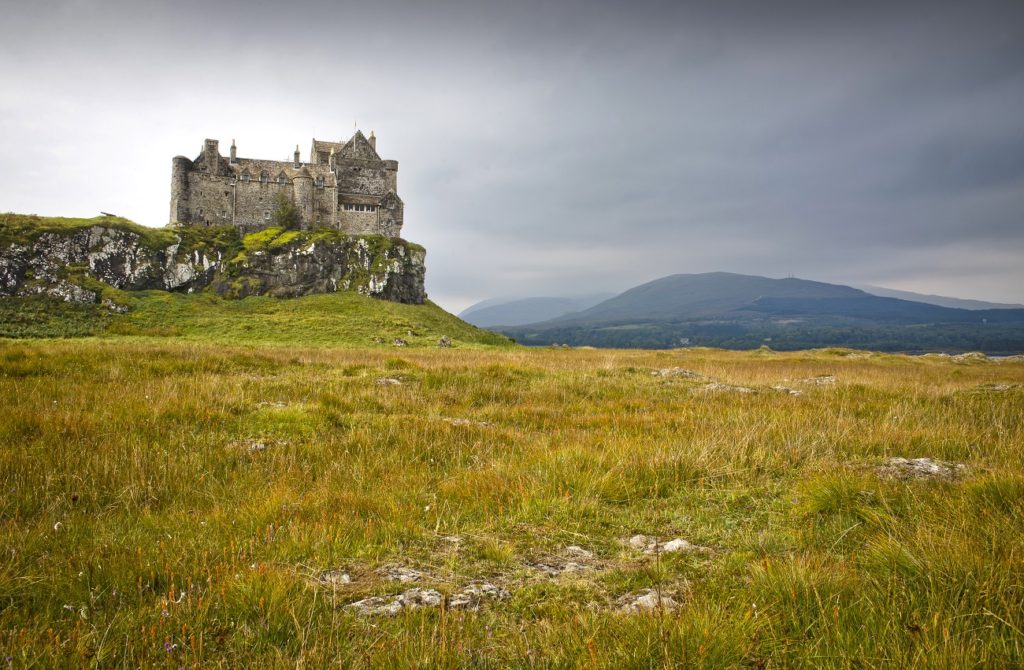
Duart Castle
Of all the castle museums in the Inner Hebrides, Duart is the most rewarding. A fortress rather than a turreted affair, it stands in a dramatic position between the Firth of Lorn and Sound of Mull.
An early MacDougall stronghold, Duart started its existence as a simple fortified dwelling. More complex additions were built later by the MacLeans who erected a tower house on four levels, incorporating one existing wall and utilising others to form a courtyard. They lost the castle in the 1670s, and it fell into disrepair over many generations until Sir Fitzroy MacLean finally bought it back in 1911.
The museum is spread across several of the (now restored) castle’s floors, beginning in the courtyard with information on the restoration, before heading inside to the kitchens, original well and dungeons, with an atmospheric recording of seagulls and a prisoner vomiting.
Upstairs, past the pantry, are a collection of fascinating Ordnance Survey diagrams from 1748, followed by the spectacular Sea Room and its unbeatable view. From here you can look out to ‘Lady’s Rock’ where, in the early 16th century, one particular Lachlan MacLean, wishing to marry another woman, dropped off his wife and left her to drown: she was then rescued and the MacLean was murdered by her brother.
Next you will enter the banquet hall, with many generations of MacLean chief portraits observing your progress around the collection of historical swords and guns. Everything is labelled, sometimes with extensive anecdotes and often, endearingly, written out by hand in fountain pen. Despite the solid rock walls, the winds howls through the castle and you are unlikely to want to take off your coat.
Upstairs again is the state bedroom and dressing room, an outrageously tall, floral, four-poster bed, and a small, but wonderful collection of 18th- and 19th-century outfits. There is a portrait of Sir Charles MacLean, painted during World War II ‘in exchange for a packet of cigarettes’ and a huge number of family photos, which may be of interest to those with a hereditary connection.
Up a tight final staircase is a rather dated timeline of objects, including cannonballs that were found in the mortar during restoration and a key from the captain’s chest of the Spanish galley that blew up in Tobermory Bay. From this level, you can access the battlements for a view of the dozens of chimneys, the Lismore Lighthouse and the mountainous mainland beyond. Once you have finished exploring the castle, take some time to visit Duart Point and look out for porpoises and dolphins, which are known to pass by.
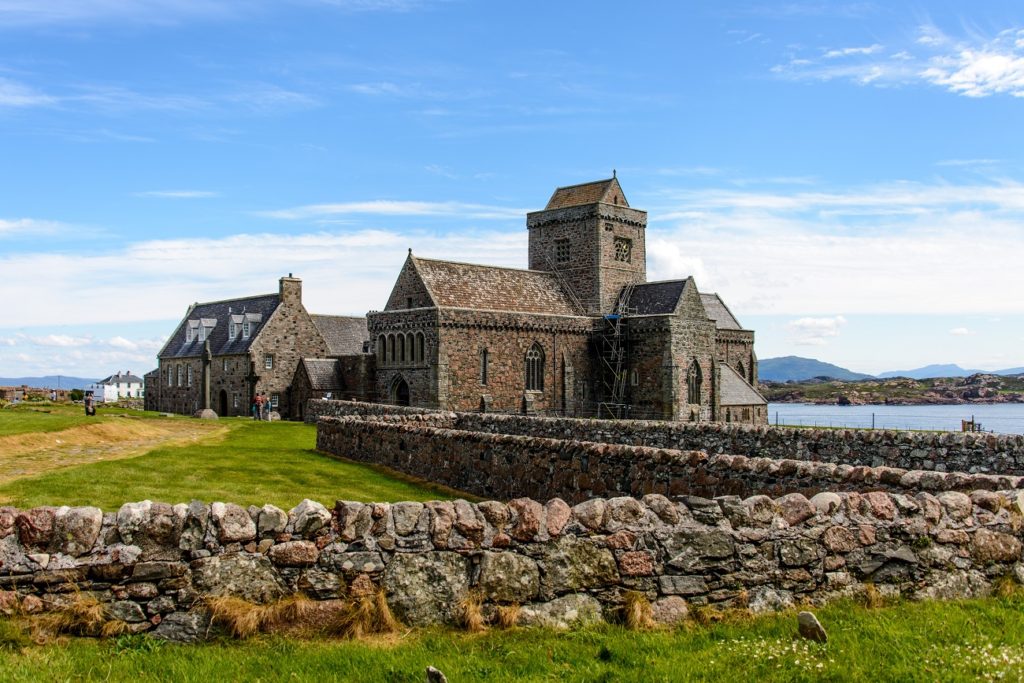
Iona Abbey
Iona Abbey is the impressive modern restoration of a grand Benedictine abbey, the original of which was begun in the 13th century. A large stone building with slate roofs, the abbey was once home to a community of monks and is now a focal point for pilgrims who visit Iona for its connection with St Columba and the centre of Christianity he founded.
Along with the abbey building itself and the historical artefacts it contains, the ticket also allows you entrance to the Abbey Museum and grounds, which encompass a number of additional interesting archaeological sites. The whole site is well maintained and explained through a comprehensive array of plaques, labels and signs, as well as the free audio guide.
In the grounds, Tòrr an Aba, a small hill to the left of the path just after the entry gate, is all that remains of what is thought to have been St Columba’s cell, which was mentioned in writing by his contemporary Adamnan. The short climb also gives a rewarding view over the abbey and the large crosses standing in its grounds, with an ocean backdrop.
Also within the grounds, the excavated Sraid nam Marbh (Street of the Dead) leads from the abbey to Reilig Odhráin burial ground, and is thought to have been part of a 1,000-year-old processional route for bodies to be carried from the landing place at Martyr’s Bay (south of the modern pier) to their final resting place. It was 7ft wide and cobbled with Ross of Mull granite, but all that remains now is an indented track with some stones exposed between overgrown grass.
The abbey interior is usually silent apart from the echoes from visitors’ careful footsteps. For pilgrims and other interested visitors, the Iona Community welcomes all to its church services (at the time of writing 09.00 & 21.00 Mon–Sat; communion: 10.30 & ‘service of quiet’ 21.00 Sun). Otherwise, you are free to wander and discover its hidden corners for yourself. The Great Church is the most grand of the abbey’s interior spaces, with high, stone archways and mighty carved pillars.
Those with a greater interest in history than religion may find the huge collection of West Highland grave slabs in the Cloister of most interest; even the large collection on Oronsay is diminished in comparison. In the Cloister, a covered walkway around a square, grass-covered courtyard, light streams through the pillars on to the swords, ships and intricate foliage carved into the stones. There is an engraving dedicated to Aonghus Óg, one-time ‘King of the Isles’ on Islay.
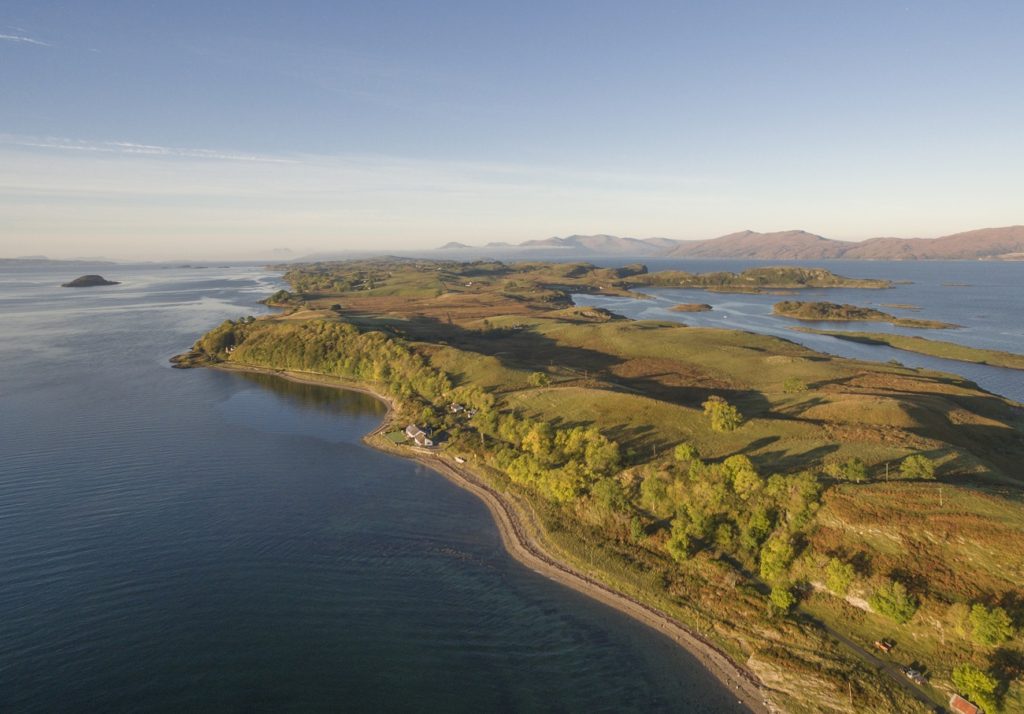
Lismore
Curiously positioned halfway up the Firth of Lorn, Lismore is separated from the mainland Highlands and Mull by just a few miles of water in every direction.
Although the island itself is low-lying, it is surrounded by mountainous scenery: Loch Linnhe cuts into the Great Glen in the northeast with the mighty Ben Nevis and Glen Coe in the distance; Ben Cruachan is on the skyline to the southeast; Mull lies to the southwest; and the wild coast of the Morvern Peninsula runs parallel to Lismore, only 3 miles to the northeast. The surrounding higher ground, particularly the hills on Mull, means that Lismore lies in a rain shadow, enjoying significantly better weather than much of its surroundings.
The island is around 9 miles long and 1½ miles wide, with a limestone base that is unusual in the Inner Hebrides; thankfully this means that midges are not an issue on Lismore. Green fields, interrupted by rocky protrusions, are separated by undulating dry-stone walls, and houses are scattered in a rather haphazard manner – the biggest settlement, Achnacroish, is barely more than a hamlet.
The island’s shop, church and heritage centre are somewhat sporadically dotted along the central main road with little else around them. In the north, Port Ramsay is picturesque but has no amenities whatsoever, while the south of the island is totally uninhabited. Despite its proximity to the mainland, Lismore feels very much like the island it is.
What to see and do
Tirefour Castle
On the east side of the island, a turning marked to ‘Balure’ leads to ruined Tirefour Castle. Despite its name, this substantial ruin is not in fact a castle but the best example of an Iron-Age broch in the whole of Argyll.
The grass-topped walls are almost 16ft tall in places and 13ft wide, enclosing a courtyard 39ft across. Complete, it may have been 49ft tall. One thing’s for certain: it commanded a magnificent position over the Lynn of Lorn, tiny Eilean Dubh island and out towards the mainland
Relics of St Moluag
Indicated by a wooden sign and visible from the road, St Moluag’s Chair is a natural seat in a rock, which sits in a field beside the road. The chair’s arms were broken off by a roadman towards the end of the 19th century. It is said that St Moluag used to sit here and meditate; sitting on it used to be considered a cure for rheumatism.
A little further south is the pretty, whitewashed local church, also known as St Moluag’s Cathedral. Visitors are welcome to join services and the door is always open at other times. This was the cathedral church of the medieval diocese of Argyll, built somewhere between the 12th and 14th centuries. Although it is dedicated to St Moluag, there are no remains here from the early Christian period, though it is likely that the building occupied the site of an earlier church dedicated to the saint. Despite its name, don’t expect a cathedral – the church is rather modest in size, though there are some wonderful carved grave slabs from the 14th and 15th century outside.
Sailein and Achadun Castle
Taking the minor road towards Achinduin on the west coast, you can turn off right to reach the farm and shoreline at Sailean, also known as Salen. Here you can see the remains of an impressive 19th-century lime quarry and kilns. The Sailean Project is based here and you might have a chance to see their Highland cows.
Further down the west coast is the 13th-century Achadun Castle, probably built by the MacDougalls. It fell out of use in the 16th century, but the ruined walls are substantial, giving you some concept of its original scale.
Rùm
The island of Rùm, with a diameter of around 8 miles, is the largest of the Small Isles. Unique among the Inner Hebrides, it appears as a cluster of mountains rising directly out of the sea. The highest point is Askival (2,664ft); the mountains are in fact the eroded roots of an ancient volcano that would have once stood around 6,560ft high.
The island’s entire small population lives in its sole settlement, the village of Kinloch on the east coast, while the rest of the island is a nature reserve, making it a particularly special place for hikers and birdwatchers.
Along with the Manx shearwaters, of which 200,000 arrive each spring, the island also provides the perfect habitat for red-throated divers, golden plovers, white-tailed sea eagles (there are two breeding pairs) and its three pairs of golden eagles. Look out for white-tailed eagles gliding over the bay, whereas golden eagles are often up above ridges. In late summer, you might be lucky enough to see basking sharks.
Approaching Kinloch on the ferry, you’d be forgiven for wondering where the village is; a couple of houses peer out from behind tall trees, but they’re strung out around the bay. Though there are a few more buildings hidden from view, the settlement is little more than that. Th at said, Rùm is surprisingly well set up to receive visitors.
The 10-minute walk along the coast from the ferry to Kinloch is well signposted and passes various buildings along the way. The small, free Visitor Centre is a good introduction to Rùm’s natural heritage and walks. It is usually unstaffed and you are welcome to visit at any time; there’s good information, games and a couple of useful amenities inside as well as a children’s playground behind. After this, you will quickly reach the Harbour BBQ Bothy and campsite, before eventually coming to the unmistakable Kinloch Castle on your left.
Apart from Kinloch, the rest of the island is wilderness. With only two proper tracks, one to Kilmory and one to Harris, and a few unmarked walking trails, further exploration requires outdoor gear, energy and supplies. The mountainous interior and rugged coastline make for endless hiking possibilities for those who are prepared.

Tobermory
A decade ago this colourful fishing port town was mostly known to a certain generation and their parents as the setting of the BBC children’s TV programme Balamory. My first visit in 2004 was accompanied by a constant background hum of the cheery theme tune; the show finished in 2005 and although it’s still possible to find related souvenirs, sanity seems to have returned to the town.
Less pricey than Skye’s Portree and with quite a bit more going on than Islay’s Bowmore, Tobermory is my personal favourite of the Inner Hebrides’ capitals and makes a good base for both solo travellers and those without their own transport. Although the colourful houses appear to have a hint of irony in a downpour, there are a good range of short indoor activities to entertain children and adults alike.
What to see and do
Tobermory Distillery
Originally established as Ledaig Distillery in 1798, Tobermory is Mull’s only distillery and one of the oldest in Scotland. It produces two contrasting single malts: the non-peated Tobermory and the heavily peated; plus a new Hebridean gin.
Mull Aquarium
Keeping animals for a maximum of four weeks, this little gem is Europe’s first ‘catch and release’ aquarium. Local fishermen and children bring in interesting species, and staff at the aquarium use them to educate visitors. Octopus, probably the most exciting marine guest, are only kept for two weeks and released before they learn how to escape their tanks.
Popular touch-pool demonstrations are hosted hourly in summer months, where visitors have a chance to hold species such as starfish, squirting scallops, hermit crabs and urchins.
Mull Museum
An endearingly old-fashioned museum crammed with invaluable, well-researched information and interesting exhibits, including delicate jewellery thought to have been lost by medieval pilgrims on their way to or from Iona.
It’s worth visiting towards the beginning of your time on the island if you’re a history or archaeology enthusiast; as well as providing vital background information, it can help you locate and interpret the most interesting archaeological sites on the island.
Tobermory Lighthouse
The lighthouse path is marked just past the RNLI centre on the left-hand side of the pier. This 2-mile return walk is easily followed along the coast, running through mature, broad-leaved woodland, with bluebells in May and the scent of wild garlic.
Eventually the view opens up across to Ardnamurchan with fishing boats bobbing in the Sound. Look out for cetaceans, which are regularly seen on this stretch of water. You will soon reach the lighthouse, which you cannot go inside. Keep a close eye on small children and dogs as there are steep drops in places.
Related books
For more information, see our guide to Inner Hebrides:
Articles about Inner Hebrides
For those who brave the elements, autumn and winter is a magnificent time when it comes to wildlife on these windswept islands.
Friends reunited!
There’s something special in the soil in the Inner Hebrides.
From idyllic waterfalls to panoramic mountain views, these islands have plenty to offer both the amateur and the ambitious.
The Scottish island is renowned across the globe for its drams.
In this interview, Walkhighlands founder Helen Webster shares her expertise from over a decade spent exploring Scotland’s Inner Hebrides.
